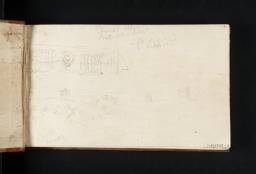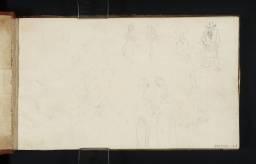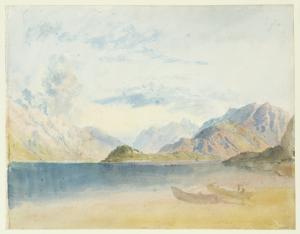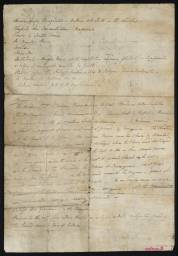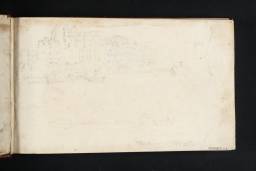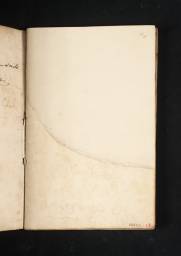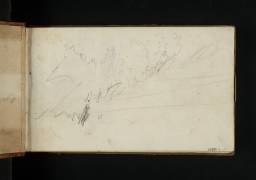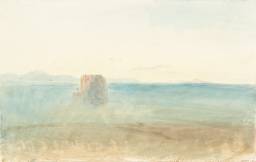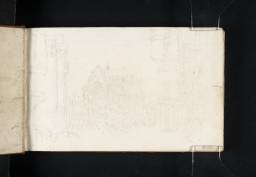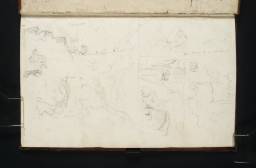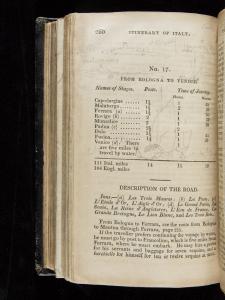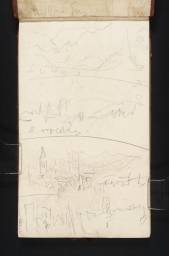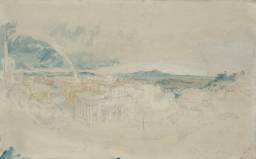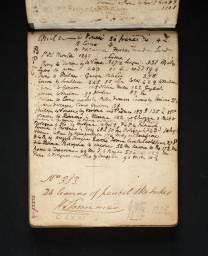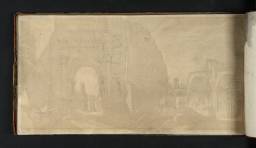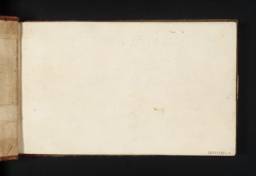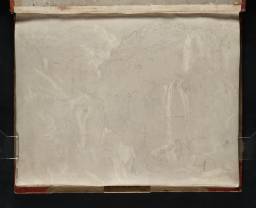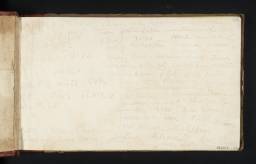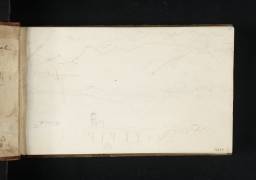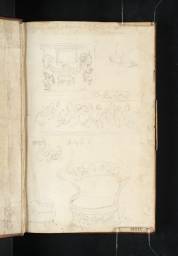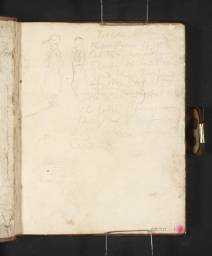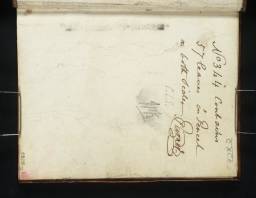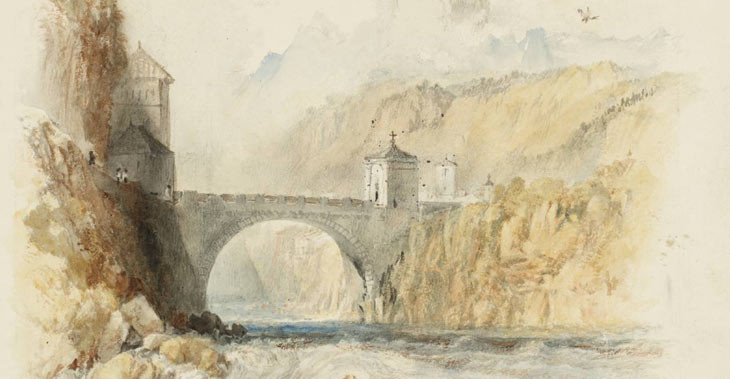First Italian Tour 1819–20
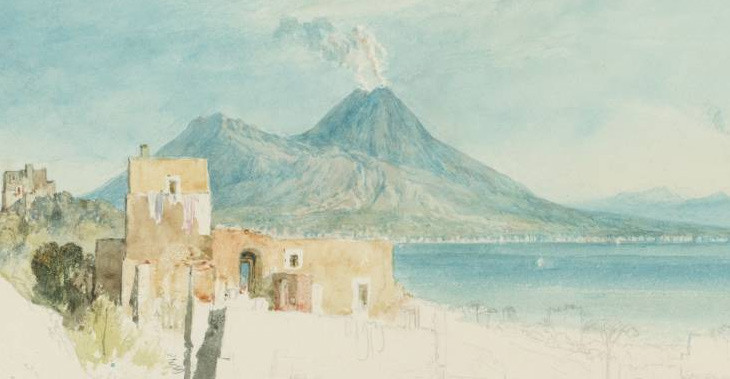
Vesuvius and the Sorrentine Peninsula from Via Posillipo 1819
(from the Naples: Rome. C. Studies sketchbook)
From the entry
Turner’s first tour of Italy in 1819–20 formed one of the most important and influential journeys of his career. Twenty-three sketchbooks and a handful of loose sheets are associated with this six month expedition which lasted from the end of July 1819 to February 1820. In common with most British artists during the early nineteenth-century, Turner’s desire to visit Italy was fuelled by the belief that the country was the cradle of western civilisation. Italian history, art and culture underpinned British taste and education during this period and, from the outset of his career, Turner was well versed in its influence. It was inevitable that he would eventually seek to experience the country’s riches for himself, considering it a necessary part of his artistic development. He had, in fact, first set foot on Italian soil in 1802, but this early exposure was limited to a brief excursion from the Alps into the Val d’Aosta, and the subsequent continuation of the Napoleonic Wars curtailed ...
Route to Rome sketchbook 1819
D13859–D13878; D13880–D13924; D13926; D13928–D13933; D40673–D40676
Turner Bequest CLXXI
D13859–D13878; D13880–D13924; D13926; D13928–D13933; D40673–D40676
Turner Bequest CLXXI
D36333 circa 1819
Turner Bequest CCCLXVIII B
Turner Bequest CCCLXVIII B
Paris, France, Savoy 2 sketchbook 1819
D13991–D14044; D14047–D14143; D40872–D40877
Turner Bequest CLXXIII
D13991–D14044; D14047–D14143; D40872–D40877
Turner Bequest CLXXIII
Turin, Como, Lugarno, Maggiore sketchbook 1819
D14144–D14189; D14192–D14325; D40887–D40889
Turner Bequest CLXXIV
D14144–D14189; D14192–D14325; D40887–D40889
Turner Bequest CLXXIV
D17158
Turner Bequest CXCV a H
Turner Bequest CXCV a H
Tivoli to Rome sketchbook 1819
D14933–D15067; D15069–D15104; D40924–D40927; D41436
Turner Bequest CLXXIX
D14933–D15067; D15069–D15104; D40924–D40927; D41436
Turner Bequest CLXXIX
Naples: Rome C. Studies sketchbook 1819
D16088–D16156; D40048; D40079; D41404–D41407; D41482; D41514
Turner Bequest CLXXXVII
D16088–D16156; D40048; D40079; D41404–D41407; D41482; D41514
Turner Bequest CLXXXVII
D17195 1819
Turner Bequest CXCVII E
Turner Bequest CXCVII E
Pompeii, Amalfi, Sorrento and Herculaneum sketchbook 1819
D15739–D15907; D40942–D40944; D41515
Turner Bequest CLXXXV
D15739–D15907; D40942–D40944; D41515
Turner Bequest CLXXXV
Bound Copy of “Reichard’s Italy” 1818
D36331
Turner Bequest CCCLXVII
D36331
Turner Bequest CCCLXVII
References
Turner’s first tour of Italy in 1819–20 formed one of the most important and influential journeys of his career. Twenty-three sketchbooks and a handful of loose sheets are associated with this six month expedition which lasted from the end of July 1819 to February 1820.1
In common with most British artists during the early nineteenth-century, Turner’s desire to visit Italy was fuelled by the belief that the country was the cradle of western civilisation. Italian history, art and culture underpinned British taste and education during this period and, from the outset of his career, Turner was well versed in its influence. It was inevitable that he would eventually seek to experience the country’s riches for himself, considering it a necessary part of his artistic development. He had, in fact, first set foot on Italian soil in 1802, but this early exposure was limited to a brief excursion from the Alps into the Val d’Aosta, and the subsequent continuation of the Napoleonic Wars curtailed any future plans for European travel until after the Battle of Waterloo in 1815.
It was therefore not until 1819, when he was a well-established, mature artist of forty-four, that Turner finally made plans for his first major Italian tour. The timing was prompted by various different factors including the patronage of the classical historian, Sir Richard Colt Hoare, the recent publication of Canto IV of Byron’s Childe Harold’s Pilgrimage, the encouragement of his Royal Academy colleague, Thomas Lawrence, and his involvement during 1818–19 with James Hakewill’s Picturesque Tour of Italy.2 Mental preparations for the forthcoming journey formed the basis of two notebooks which he carried with him during his travels: the Route to Rome sketchbook (Tate; Turner Bequest CLXXI), containing advice from Hakewill; and the Italian Guide Book sketchbook (Tate; Turner Bequest CLXXII), in which Turner made his own notes and drawings from John Chetwode Eustace’s A Classical Tour Through Italy and the topographical print publication, Select Views in Italy, with Topographical and Historical Descriptions, in English and French by John ‘Warwick’ Smith, William Byrne and John Emes. He also purchased a copy of the travel guidebook, Reichard’s Italy, published 1818 (Tate; Turner Bequest CCCLXVII).
When travelling between places during this trip Turner generally used his sketchbooks sequentially. His on-the-spot drawings therefore represent a tangible record of his itinerary. This is particularly true of the outward leg of the journey as far as Rome. Turner departed England at the beginning of August 1819 and, as an inscription in the Paris, France Savoy 2 sketchbook records, he crossed the Channel from Dover to Calais in a packet boat.3 Although there were several established routes to Italy at this time, he chose the most direct road through France via Paris, Auxerre, Lyon and Chambéry, crossing the Alps at the Mont Cenis Pass (see the Paris, France Savoy 2 sketchbook, Tate; Turner Bequest CLXXIII). Upon entering Italy he continued east to Turin and Milan before heading north for a tour of the Italian lakes and a brief excursion into the Swiss Alps to see the Simplon Pass (Turin, Como, Lugarno, Maggiore sketchbook, Tate; Turner Bequest CLXXIV and Passage of the Simplon sketchbook, Tate; Turner Bequest CXCIV). Having retraced his steps to Milan he then continued eastwards to Lake Garda, Verona, Padua and Venice (Milan to Venice sketchbook, Tate; Turner Bequest CLXXV). After a few days exploring Venice (see the Como and Venice sketchbook, Tate; Turner Bequest CLXXXI), Turner resumed the journey southwards, first to Bologna, and then following the Adriatic coastline to Ancona (Venice to Ancona sketchbook, Tate; Turner Bequest CLXXVI). At Ancona he took the south-westerly route directly for Rome, crossing through Umbria and the Apennine Mountains (Ancona to Rome sketchbook, Tate; Turner Bequest CLXXVII), and arriving in the Eternal City at the beginning of October.
Turner’s use of sketchbooks was more complicated in the key cities and towns which formed the main axis of his travels, Rome, Tivoli and Naples. These locations contained many of the most important and celebrated sights of ancient and modern Italy and rather than merely passing through, Turner lingered for several days or even weeks, exploring and documenting their treasures. In these instances he employed sketchbooks simultaneously, interchanging different formats and types of paper according to his varying needs.4 In Tivoli, for example, the artist used three sketchbooks (Tivoli to Rome, Tivoli and Naples: Rome C. Studies, all Tate; Turner Bequest CLXXIX, CLXXXIII and CLXXXVII), and his studies range from swift pencil sketches to more detailed tonal compositions and even some watercolours. Similarly, Neapolitan subjects can be found across four sketchbooks (Naples: Rome C. Studies, Gandolfo to Naples, Pompeii, Amalfi, Sorrento and Herculaneum and Naples, Paestum, Rome, all Tate; Turner Bequest CLXXXVII, CLXXXIV, CLXXXV and CLXXXVI). The latter three books also record Turner’s journey between Rome and Naples, as well as his travels around Sorrento, the Amalfi coast and Paestum, the most southerly point of his Italian travels. Finally, nine sketchbooks contain views and studies relating to Rome and the surrounding campagna.5 Of these, five are comprised of on-the-spot pencil sketches (Vatican Fragments, St Peter’s, Albano, Nemi, Rome, Tivoli to Rome and Rome and Florence, all Tate; Turner Bequest CLXXX, CLXXXVIII, CLXXXII, CLXXIX and CXCI), whilst three include drawings executed on a tonal grey background or enhanced with colour (Rome: C. Studies, Small Rome C. Studies and Naples: Rome C. Studies, all Tate; Turner Bequest CLXXXIX, CXC and CLXXXVII). The final example, Remarks (Italy) sketchbook (Tate; Turner Bequest CXCIII) contains rough, schematic copies and notes on works of art in Roman collections.
Turner left Rome in the middle of December 1819 and embarked upon the return trip to England.6 He chose a different route from the outward journey, opting to take the road via Perugia and Arezzo to Florence where he paused for several days, sketching the city and exploring the churches, palaces and the Uffizi (see the Rome and Florence sketchbook, Tate; Turner Bequest CXCI). The final section of his Italian tour took him through Bologna and Parma back to Milan and Turin, before recrossing the Alps at the Mont Cenis Pass, a dramatic experience which he later immortalised in a watercolour for Walter Fawkes, Snow Storm, Mont Cenis, 1820, watercolour on paper (Birmingham Museum and Art Gallery).7 The last leg of the journey in northern Italy and France is recorded through sketches in the Return from Italy sketchbook (Tate; Turner Bequest CXCII).
Collectively Turner’s 1819 Italian sketchbooks formed a huge repository of visual material which informed his work for many years following the actual tour. Interestingly the idiosyncratic, obscure system which he used in the studio to number and label his sketchbooks commences with a selection of these books, suggesting that he valued them particularly highly. Their most immediate use is evident within three oil paintings completed in the months and years following his 1819 trip: Rome from the Vatican. Raffaelle Accompanied by La Fornarina, Preparing his Pictures for the Decoration of the Loggia, exhibited 1820 (Tate, N00503);8 The Bay of Baiae, with Apollo and the Sibyl, exhibited 1823 (Tate, N00505);9 and Forum Romanum, exhibited 1826 (Tate, N00504).10 Preparatory and related sketchbook studies can be found for all three pictures. Turner also completed a series of Italian watercolours for Walter Fawkes, many of which derive directly from drawings,11 as well as other selected views which were ultimately engraved for the Keepsake, 1828–9.12 Even after Turner had undertaken a second tour of Italy in 1828, echoes from the first continued to resonate, for example in his vignette illustrations for Rogers’s Italy, 1830, and in some of the later Italian oils.13
The most comprehensive accounts of the first Italian tour can be found in: Cecilia Powell, Turner in the South: Rome, Naples, Florence, New Haven and London 1987; Ian Warrell, David Laven, Jan Morris and others, Turner and Venice, exhibition catalogue, Tate Britain, London 2003; and James Hamilton, Nicola Moorby, Christopher Baker and others, Turner & Italy, exhibition catalogue, National Galleries of Scotland, Edinburgh 2009.
For a detailed discussion see Nicola Moorby, ‘An Italian Treasury: Turner’s Sketchbooks’, in Hamilton et al 2009, pp.111–7.
Despite its title, the Naples, Paestum and Rome (CLXXXVI) sketchbook does not appear to contain any views of Rome and the Route to Rome sketchbook (CLXXI) contains notes but no identified sketches.
See Powell 1987, p.90. However, James Hamilton has suggested that Turner left Rome in early January 1820. See Hamilton 2009, p.55.
How to cite
Nicola Moorby, ‘First Italian Tour 1819–20 ’, May 2011, in David Blayney Brown (ed.), J.M.W. Turner: Sketchbooks, Drawings and Watercolours, Tate Research Publication, December 2012, https://www

